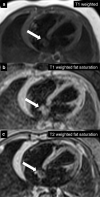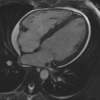Society for Cardiovascular Magnetic Resonance 2019 Case of the Week series
- PMID: 33794918
- PMCID: PMC8015162
- DOI: 10.1186/s12968-020-00671-7
Society for Cardiovascular Magnetic Resonance 2019 Case of the Week series
Abstract
The Society for Cardiovascular Magnetic Resonance (SCMR) is an international society focused on the research, education, and clinical application of cardiovascular magnetic resonance (CMR). The SCMR web site ( https://www.scmr.org ) hosts a case series designed to present case reports demonstrating the unique attributes of CMR in the diagnosis or management of cardiovascular disease. Each clinical presentation is followed by a brief discussion of the disease and unique role of CMR in disease diagnosis or management guidance. By nature, some of these are somewhat esoteric, but all are instructive. In this publication, we provide a digital archive of the 2019 Case of the Week series as a means of further enhancing the education of those interested in CMR and as a means of more readily identifying these cases using a PubMed or similar search engine.
Keywords: Cardiac tumor; Cardiomyopathy; Eosinophilic granulomatosis; MRI.
Conflict of interest statement
There are no competing interests.
Figures

































References
-
- Masi AT, Hunder GG, Lie JT, Michel BA, Bloch DA, Arend WP, Calabrese LH, Edworthy SM, Fauci AS, Leavitt RY, Lightfoot RW, McShane DJ, Mills JA, Stevens MB, Wallace SL, Zvaifler NJ. The American College of Rheumatology 1990 criteria for the classification of Churg-Strauss syndrome (allergic granulomatosis and angiitis) Arthritis Rheum. 1990;33:1094–1100. doi: 10.1002/art.1780330806. - DOI - PubMed
-
- Dennert RM, van Paassen P, Schalla S, Kuznetsova R, Alzand BS, Staessen JA, Velthuis S, Crijns HJ, Tervaert JW, Heymans S. Cardiac involvement in Churg-Strauss syndrome. Arthritis Rheum. 2010;62:627–634. - PubMed
-
- Salemi VMC, Rochitte CE, Shiozaki AA, Joalbo MA, Parga JR, de Avila LF, Benvenuti LA, Cestari IN, Picard MH, Kim RJ, Mady C. Late gadolinium enhancement magnetic resonance imaging in the diagnosis and prognosis of endomyocardial fibrosis patients. Circ Cardiovasc Imaging. 2011;4:304–311. doi: 10.1161/CIRCIMAGING.110.950675. - DOI - PubMed
Publication types
MeSH terms
Substances
LinkOut - more resources
Full Text Sources
Other Literature Sources
Medical

